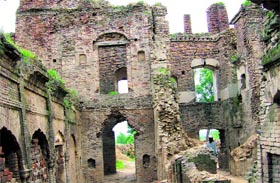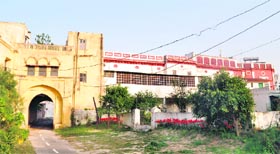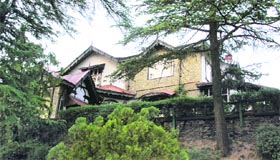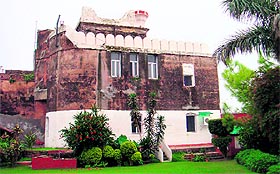|
Living heritage
Charandeep
Singh takes a look at some family forts of Punjab and
Himachal Pradesh, which continue to maintain their royal customs
and traditions
|

Present owner Gurjitinder Singh Virk plans to resurrect the Kandhola Fort.
Tribune photo: Amit Kanwar
|
Undivided
Punjab’s martial history and cultural heritage is chronicled
in many forts that dot various parts of the state. Luckily, most
of those who have inherited these stellar monuments are strong
willed to preserve these heritage buildings. Gurjitinder Singh
Virk (64) runs a fish farm at Sri Chamkaur Sahib. "The only
unaccomplished task I have in my life is to resurrect the
Kandhola Fort, which was bequeathed to me. The fort is in a
state of dilapidation. I have got the blueprints ready, on how
to reconstruct this majestic old structure. I would be using the
same ‘Nanakshahi brick’, which was used in the original
structure," informs Gurjitinder. Kandhola Fort is spread
over one acre and the reconstruction would cost nearly Rs 6
crore.
Is it an act of
obsession? "No, it is the preservation of my family
heritage, which, if not preserved, will soon go into oblivion. I
have to restore my fort so that my family name continues,"
observes Gurjitinder. `A0
To maintain
these forts in their puritanical form is a Herculean task. But
it also gives an insight to the coming generations about the
life and times of their forefathers. "I have maintained the
structure in its original form. Even the wallpapers remain the
same as when my grandfather renovated it in 1940. I have also
preserved the Gobelin tapestries and cabinets from Doge’s
Palace in Venice. You can find these only here or in some old
British mansions in England. I have maintained the same
lifestyle and use the same old silverware belonging to my
grandfather in which the tea is still served, and even the
distinct style with which the food is served and table is laid,
still continues. This continuance of the old royal lifestyle is
the intangible heritage which I have preserved and passed on to
my son and grandson," says a beaming Kanwar Ratanjit Singh
of Chapslee House, Shimla, which was the summer residence of
Maharaja of Kapurthala.
|

The Kathgarh Fort is near Nawanshahr, Punjab.
Tribune photo: Amit Kanwar
|
With many
original owners still residing in forts, many of which are away
from the urban landscape and culture, life can be a bit secluded
and monotonous. There are no neighbours around. Even the urban
centres are far away and to commute everyday can be cumbersome.
"I was born and brought up in Chandigarh. After marriage, I
had to live in the Bharatgarh fort where my in-laws resided. It
was a cultural shock for me. At times, loneliness used to catch
up. But I adjusted and now I feel proud of myself, since I am
preserving a legacy with my family," expresses Maninder
Kaur who is married to a descendent of Singhpuria Misl and owner
of Bharatgarh Fort, near Anandpur Sahib.
These forts
have special significance in their family folklore also.
"We have the samadhs of all our ancestors right on
the entrance of our fort. On Diwali we light candles on these samadhs.
All our family marriages also take place in the fort only. We
take pride in calling ourselves as the Kathgarh family,"
says Rajpal Singh Mahal (87), oldest member of the Kathgarh
family. This fort is near Nawanshahr.
The maintenance
of these forts takes quite a toll on the finances of the owners.
But some enterprising minds have converted their property into
heritage stays so that these properties become sustainable.
"These forts as such are white elephants. It is easier to
maintain a new structure with similar dimensions, rather than
maintaining these ancient structures. Since the size is very
big, it becomes a bit easy to encash the vacant area and convert
them into heritage stays so that they become self
sustainable," adds Amar Chandel, who has converted his
Ramgarh Fort into a heritage hotel.
|

The Chapslee House in Shimla was the summer residence of Maharaja of Kapurthala.
Tribune photo: Amit Kanwar
|
On the issue of
commercialising the heritage properties Kanwar Ratanjit Singh of
Chapslee has an interesting anecdote, "When I shifted to
Chapslee House in the early 1970s, we started a school there. To
fund the expenses of the school, I was toying with the idea of
converting Chapslee House into a guesthouse. Then a friend of
mine gifted me a book, written by Lord Bedford, titled How to
be a snob? He wrote that if the royalty opens up their
residences, the commoners will have a privilege to see these
residences and they will even pay for it. I, too, opened up
Chapslee Palace for people. Now people come to see Chapslee
House for which they pay me," informs Kanwar Ratanjit.
The owners of
Bharatgarh Fort also plan to convert a secluded portion of the
fort into a heritage resort. "We spend around Rs 7 lakh
annually on the maintenance of the fort. We thought of
converting a portion into a heritage stay, so that the fort
becomes self sustainable", says Deepinder Singh of
Bharatgarh Fort.`A0
 This concept of
having a brush with the royalty and enjoying a stay in the
environs of these forts has gone down very well with the public
at large. Most of these forts have some customs and traditions,
endemic to them. For example, the Ramgarh royal family is of
strict vegetarians and the same trend continues in their
heritage stay also. This concept of
having a brush with the royalty and enjoying a stay in the
environs of these forts has gone down very well with the public
at large. Most of these forts have some customs and traditions,
endemic to them. For example, the Ramgarh royal family is of
strict vegetarians and the same trend continues in their
heritage stay also.
Most of these
heritage stays or resorts are individual efforts by the owners.
A light push from the state government can make these heritage
stays a hit with tourists. If these heritage stays are promoted
at a national level — as is being done in Rajasthan and even
in some European nations, who are promoting their castles.
Since the maintenance of these
properties a costly affair, doesn’t it make sense to dispose
them off? `A0"This is my heritage. It is priceless. I
cannot even put a price on it,’ observes Kanwar Ratanjit.
"These ancient structures are the hallmark of our
existence. I am the ninth successive generation living in this
fort, I cannot even think of selling it up," winds up
Deepinder Singh of Bharatgarh, with pride in his eyes.
|